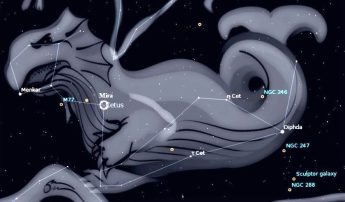This Week’s Sky at a Glance, 2025 Oct 18 – Oct 25
This Week’s Sky at a Glance, 2025 Oct 18 – Oct 25
Mid-autumn is a time for late-evening whale watching while the large constellation of Cetus the Whale is approaching the southern sky. Many of its stars are not particularly bright so it can be elusive, but you can piece it together in a fairly dark sky. The eastern side of the square of Pegasus is a handy arrow that points down toward Diphda, the brightest star in Cetus. Also called Deneb Kaitos, “the tail of the whale,” it anchors a pentagram of stars forming the rear half of Cetus below dim Pisces. A circlet of stars to the upper left, west of Taurus, is the whale’s head. In mythology, Cetus represents the sea monster created by Poseidon to ravage the coastal area of Ethiopia as punishment for Queen Cassiopeia’s boasting of her daughter Andromeda’s beauty.
A famous star in Cetus is Mira, perhaps the first star to be recognized as a variable or one that changes its brightness regularly. The name Mira translates as “wonderful.” It is a red giant star that expands and contracts, while brightening as it expands. At minimum brightness it cannot be seen with binoculars but every 11 months it brightens to easy naked eye visibility. Midway on the western side of the circlet of the whale’s head is a star which anchors an asterism that resembles a question mark. Don’t ask why, just try it with binoculars. A scope or binoculars could reveal the galaxy M77 approximately midway between Mira and Menkar, the star at the bottom of the circlet.
This Week in the Solar System
Saturday’s sunrise in Moncton is at 7:40 and sunset will occur at 6:27, giving 10 hours, 47 minutes of daylight (7:44 and 6:33 in Saint John). Next Saturday the Sun will rise at 7:50 and set at 6:15, giving 10 hours, 25 minutes of daylight (7:54 and 6:21 in Saint John).
The Moon is near Venus Sunday morning, two days before reaching the new moon phase. In Thursday evening twilight it anchors a southwestern line-up to the upper right with Mercury and Mars, but binoculars and a cloudless horizon will be required to see them. Saturn is at its highest and best for observing around 11 pm, and Jupiter will be rising a half hour later. The Orionid meteor shower peaks on Tuesday, with shooting stars emanating from his mighty club above orange Betelgeuse in his shoulder. For the next two weeks rural observers might see the zodiacal light in the morning sky 90 minutes before sunrise, a subtle wedge of scattered sunlight angling up toward Jupiter. For a bonus treat two speedy comets are within binocular viewing range, with 2025 A6 Lemmon scooting through Bootes at its closest to Earth, and 2025 R2 SWAN zipping through Scutum and Aquila. See the Heavens Above website for their location at any time.
Tune in to the Sunday Night Astronomy Show at 8 pm on the YouTube channel and Facebook page of Astronomy by the Bay.

